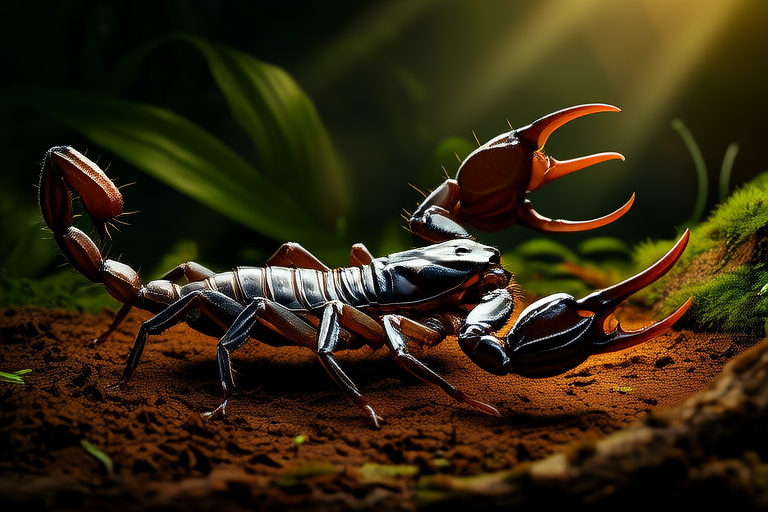Adventures with Heterometrus Spinifer: A Journey into the Heart of the Jungle
The dense, emerald canopy of the jungle stretches endlessly above, filtering the sunlight into a dappled dance of green and gold. The air is thick with humidity, carrying the scent of damp earth and the faint, sweet perfume of blossoms. This is the domain of the Heterometrus spinifer, a species of huntsman spider native to Southeast Asia. My journey into the heart of this jungle has been nothing short of an adventure, filled with both challenges and rewards.
Introduction to Heterometrus Spinifer
The Heterometrus spinifer, often referred to as the hairy huntsman, is a large, agile spider known for its distinctive appearance and remarkable speed. With a body length that can reach up to 8 centimeters and legs that span nearly 20 centimeters, it is one of the largest spiders in the region. Its name, derived from the Latin ‘Hetero’ meaning different or other and ‘metron’ meaning measure, alludes to its unique physical characteristics. The ‘spinifer’ part of its name refers to the small spines on its legs, which give it a slightly menacing look but serve more as a defense mechanism against predators.
The Natural Habitat
The Heterometrus spinifer thrives in the humid, tropical rainforests of Southeast Asia, particularly in countries like Thailand, Malaysia, and Indonesia. These spiders are predominantly nocturnal, preferring the cool, dark underbrush where they can hunt for insects and other small prey. They are adept at climbing trees and rocks, often making their homes in crevices or under bark. Their ability to move swiftly across various surfaces allows them to evade predators and catch their own meals efficiently.
Behavior and Diet
Huntsman spiders are primarily carnivorous, feeding on a variety of insects and even small vertebrates such as frogs and lizards. Their hunting strategy involves lying in wait or actively stalking their prey, utilizing their excellent eyesight and lightning-fast reflexes. Unlike many spiders that rely on webs to ensnare their victims, huntsman spiders prefer to chase down their prey directly. Once caught, they inject venom into their victim, paralyzing it before consuming it.
The venom of the Heterometrus spinifer is potent but not typically dangerous to humans unless provoked. It serves a dual purpose: incapacitating prey and deterring potential threats. Despite their intimidating size, these spiders are generally shy and will avoid confrontation with larger animals, including humans.
The Role in the Ecosystem
In the intricate web of life within the jungle, the Heterometrus spinifer plays a crucial role as both predator and prey. By controlling insect populations, they help maintain ecological balance. As prey, they contribute to the diets of birds, reptiles, and other larger predators. Their presence underscores the importance of biodiversity and the interconnectedness of all living things within the ecosystem.
The Challenges of the Jungle
Entering the jungle in search of the Heterometrus spinifer is no easy feat. The terrain is rugged, with dense vegetation and treacherous underfoot conditions. The heat and humidity can be overwhelming, and the constant threat of other wildlife adds an element of danger. However, these challenges are part of what makes the experience so exhilarating.
One of the primary difficulties is simply finding the spiders. Their coloration blends seamlessly with the forest floor, making them difficult to spot even when you know exactly where to look. Patience and persistence are key. I have spent countless hours crawling through underbrush, scanning every leaf and crevice, often with little success. But the moments of discovery make it all worthwhile.
Another challenge is the sheer volume of other creatures sharing the same space. While most are harmless, some can pose significant risks. Venomous snakes, aggressive insects, and unpredictable weather all add layers of complexity to the expedition. Safety precautions, such as wearing protective clothing and carrying essential supplies, are non-negotiable. Yet, each encounter with the jungle’s inhabitants deepens my appreciation for the diversity of life and the delicate balance that sustains it.
The Rewards of Observation
Despite the challenges, the rewards of venturing into the jungle to observe the Heterometrus spinifer are profound. There is something indescribably magical about witnessing these creatures in their natural habitat. The first time I saw a Heterometrus spinifer scuttle across the forest floor, its long legs moving with a fluid grace, was a moment of pure awe. Each sighting is a reminder of the beauty and complexity of nature.
Observing these spiders in action also provides valuable insights into their behavior and biology. Watching them hunt, interact with their environment, and respond to external stimuli offers a window into their world. Through careful observation, I’ve learned that they are not just passive residents of the forest but active participants in its ongoing drama.
Conclusion
My adventures with the Heterometrus spinifer have been a transformative experience, offering both personal growth and a deeper understanding of the natural world. The challenges of exploring the jungle have honed my patience and resilience, while the rewards of discovery have enriched my appreciation for the intricate tapestry of life. Whether you’re an avid nature enthusiast or simply curious about the creatures that inhabit our planet, the journey into the heart of the jungle is an invitation to explore, learn, and connect with the wonders of the wild.
